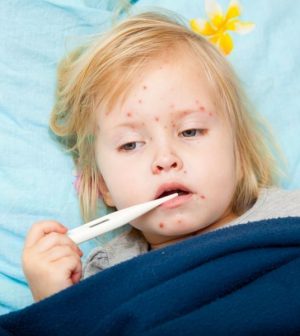- Skip Storing This Everyday Product in the Fridge Door
- Green Tea + B3 Pairing May Boost Brain Health
- Navigating Your Midlife Crisis: Embracing New Possibilities
- City Raccoons Showing Signs of Domestication
- Mapping the Exposome: Science Broadens Focus to Environmental Disease Triggers
- One Week Less on Social Media Linked to Better Mental Health
- Your Brain Changes in Stages as You Age, Study Finds
- Some Suicide Victims Show No Typical Warning Signs, Study Finds
- ByHeart Formula Faces Lawsuits After Babies Sickened With Botulism
- Switch to Vegan Diet Could Cut Your Greenhouse Gas Emissions in Half
Driven by Anti-Vaxxers, Measles Outbreaks Cost Everyone Money

A single measles outbreak cost one U.S. county $3.4 million, a new government study estimates, underscoring the societal burden of inadequate vaccination rates.
The outbreak occurred in Clark County, Wash., in early 2019, and ultimately infected 71 people — mostly children younger than 10 who hadn’t received the measles-mumps-rubella (MMR) vaccine.
The county’s low MMR coverage is believed to have left it vulnerable, according to Jamison Pike, a researcher at the U.S. Centers for Disease Control and Prevention who led the study.
Around the time of the outbreak, 81% of 1- to 5-year-olds in the county had received one MMR dose, and 78% of older kids had received both doses. In contrast, an average of 94% of kindergarteners nationwide had received both MMR doses.
The misery — and danger — of measles is well documented. The viral infection causes a high fever, cough, runny nose and rash. In some cases it leads to complications like pneumonia and swelling of the brain.
According to the CDC, about 20% of Americans who contract measles end up in the hospital, while 1 to 3 in every 1,000 die.
But there is also an economic toll, Pike said. When an outbreak strikes, public health agencies jump into action, performing testing, contact tracing and vaccination of susceptible people.
Then, Pike said, there is the lost productivity when people exposed to measles have to quarantine, or stay home to care for a sick family member. During the Clark County outbreak, 839 people went into quarantine — with three weeks being the recommended duration.
Pike and her colleagues estimate that the public health response alone cost about $2.3 million. Productivity losses, meanwhile, added up to just over $1 million. Direct medical costs tacked on another $76,000.
While the number of measles cases was not huge, at 71, each case cost the county more than $47,000, the CDC team estimates.
Yet those figures do not capture the full bill, according to Pike. For one, the Clark County outbreak was linked to additional measles cases, in Oregon and faraway Georgia.
It’s also hard to account for all the societal costs, Pike said. As one example, a measles outbreak can divert resources from routine public health services, such as nutrition programs and surveillance of other diseases.
“There are ripple effects,” Pike said. “It’s not only the infectious disease that spreads.”
Dr. Jessica Cataldi wrote an editorial published with the study March 12 in Pediatrics. She agreed it’s important to understand the economic fallout of measles outbreaks.
“It really does reflect the shared impact in the community,” said Cataldi, a pediatric infectious disease specialist at Children’s Hospital Colorado and University of Colorado Anschutz Medical Campus in Aurora.
Due to the pandemic, she said, many people now grasp the burden of quarantining and needing time off from work to recover from illness or care for a family member.
But the broader public health response to disease outbreaks, which are publicly funded, also affects the community, Cataldi said.
The year of the Clark County outbreak, 2019, was a bad measles year for the United States. The country saw its highest number of cases since 1992, according to the CDC. The largest outbreak occurred in New York, primarily affecting a Brooklyn Orthodox Jewish community with low vaccination rates.
In the United States, the CDC says, measles outbreaks generally happen when a traveler brings the virus into the country, and it then spreads among clusters of unvaccinated people — often fostered by “anti-vaxxer” sentiment among some parents.
Cataldi said measles is highly contagious — much more so than COVID-19, in fact. So even a small decline in MMR coverage can make a community vulnerable.
“This is why we vaccinate,” Cataldi said.
During the pandemic, when many U.S. children were not getting routine checkups, vaccination rates plummeted.
If your child fell behind on the recommended vaccine schedule, Cataldi said, “now is the time to get caught up.”
Parents can make the mistake of believing they do not need to vaccinate their child because other people are vaccinated. But, Pike said, when enough people take that position, herd protection wanes.
One difficulty, she noted, is actually locating the “under-vaccinated pockets” that dot the United States, to better understand what is going on in those places. Those pockets may not become apparent until a disease outbreak hits.
More information
The American Academy of Pediatrics has more on measles.
SOURCES: Jamison Pike, MS, PhD, health economist, U.S. Centers for Disease Control and Prevention, Atlanta; Jessica Cataldi, MD, pediatric infectious disease specialist, Children’s Hospital Colorado, University of Colorado Anschutz Medical Campus, Aurora; Pediatrics, March 12, 2021, online
Source: HealthDay
Copyright © 2025 HealthDay. All rights reserved.










